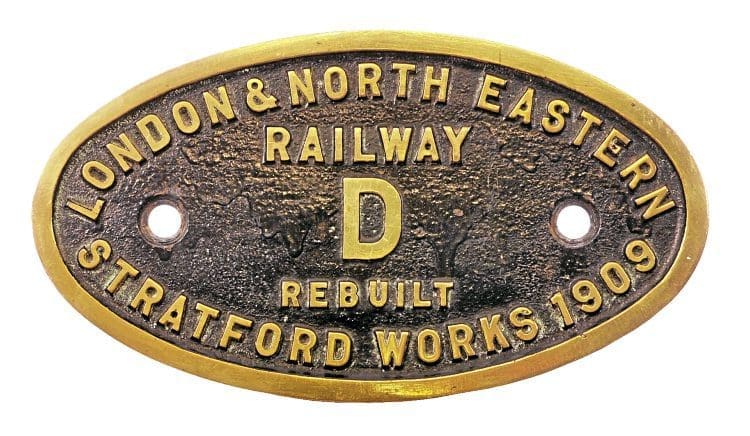HEREFORD may have been at the heart of GWR territory, but the cathedral city joined forces with the LMS at Great Central’s June 2 sale at Stoneleigh Park to demolish the opposition, when nameplate City of Hereford from Princess Coronation No. 46255 sold for £22,000.
The plate from the 1946-built Pacific was the only five-figure realisation under the hammer, although Devizes Castle from GWR No. 7002, also built in 1946, sold at half-time at its reserve of £12,000.
The LMS also featured at the head of the four-figure realisations, with Oberon from LNWR Precursor class 4-4-0 No. 2164/LMS No. 25277 selling for £8400, closely followed at £8200 by Castle Hedingham (LNER B2 No. 61614) and at £8100 by Sir Ironside from SR King Arthur No. 30799.
Enjoy more Heritage Railway reading in the four-weekly magazine.
Click here to subscribe & save.
Completing the main line steam nameplates sold under the hammer were Minoru (LNER A3 No. 60062), Linette (BR Standard Class 5 No. 73087) and Nanhoran Hall (GWR No. 4947), at £7000, £6300 and £4400 respectively. Cudworth, from LBSCR Remembrance class 4-6-0 No. 32330, went to a new home at its reserve of £7000 following its sale after close of play.
A quartet of nameplate non-sellers comprised GWR pair Prince Albert and Wyke Hall (Nos. 4042 and 7929, the latter the last member of its class to be constructed), Eire (LMS Jubilee No. 45572), and Byron (Standard Britannia No. 70031).
A ‘Brit’ did shine in the smokebox numberplate category, when that from No. 70012 John of Gaunt went for £4000, way ahead of the £1650 achieved by the runner-up, a plate from Midland Railway/LMS 0-4-4T No. 1429. Top BR totem station signs were Chesterfield Midland (£4800) and Waterloo (£4300), and leading SR target sign Torrington (£1450).
Still with signs, a cast iron Wye Valley Railway trespass warning sold for £4700 and a BR(S) enamel fascia sign from Hellingly station for £2000, and top of the signalling items were an LSWR Tyer’s train describer (£3600) and a pair of Walker’s ex-Redhill describers (£2150).
In the days of yore, the worksplate and cabside selections were the domain of steam, but times are changing. Thus at Stoneleigh, steam was eclipsed by diesel and electric in both categories, with the worksplates being led by a 1960 BR Darlington example from an unidentified Class 24 Type 2 in the D5094-D5119 series (£2200), and the cabsides by E3032 from a West Coast Main Line Class 83 later renumbered 83009 (£3200).
Top electric worksplate at £1200 was a 1952 Gorton plate from Class EM1 No. 26033, while the steam leader was a 1909 LNER Stratford rebuilt from a crane 0-6-0T given the letter D early in its life rather than a number, but numbered 68669 by BR and withdrawn in 1950 (£1150). Among the cabsides, the leading diesel was D1028 from Class 52 Western Hussar (£1900), and head of the steam selection was 1447 from a GWR 0-4-2T built in 1935 and withdrawn in 1964 (£1800).
A steam era headboard from ‘The Thames-Clyde Express’ went for £4200, a 1976 painting by Don Breckon of SR Battle of Britain class Pacific No. 34051 Winston Churchill on an Up express beside the Tamar between St Budeaux and Bere Alston, sold for £3500, and a Lynton & Barnstaple Railway poster board header for £2000. Prices exclude buyer’s premium of 15% (+ VAT).
Auctioneer Mike Soden said: “Totems are as buoyant as they have ever been, signalling is very strong, and City of Hereford shows that the best nameplates are holding their own. The appeal of ‘The Thames-Clyde Express’ headboard was doubtless due to its route including the Settle to Carlisle line and it going into Glasgow St Enoch in the steam era.”
Read more auction news in Issue 243 of HR – on sale now!
Advert
 Enjoy more Heritage Railway reading in the four-weekly magazine. Click here to subscribe.
Enjoy more Heritage Railway reading in the four-weekly magazine. Click here to subscribe.




